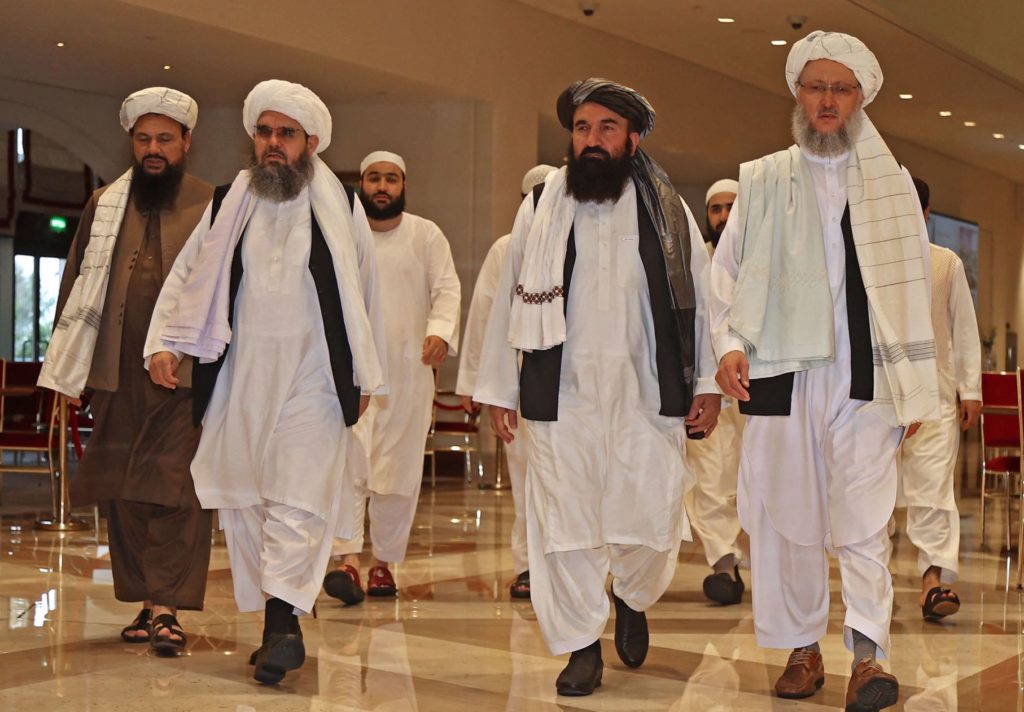
It has already been said that the consolidation of hadith as itself constituting the religion and the relegation of the Qur’ān practically to the status of a secondary source took place in the era of the second revival of hadith scholarship under Ibn al-Ṣalāḥ and Ibn Taymiyya, followed by then a subsequent generation famous for its commentaries on the Ṣaḥīḥ collections such as those by Ibn Ḥajar al-‘Asqalānī, al-Dhahabī, al-Suyūṭī and al-Nawawī and others.
BY SAMEH ASKER
BY CIRCULATING IN THE ORBIT of these narrators and their fallacies and errors, hadith scholars departed from the circle of rational criticism and refrained from examining them. They limited their vision to justifying and excusing earlier hadith scholars and to enhancing the sanctity and consolidation of the ‘six’ and ‘nine’ collections. They did not pay much attention to any of the contradictions and clear repudiations that existed between the authors of these books, and went on to put in rules to psychologically intimidate students from delving into these conflicts and repudiations, or from conducting any rational research into the fact of how they came about at all, which were held to be ‘the words of peers to be shut off and not retold’ – meaning that these hadith scholars and authors of the ‘nine’ collections are untouchable peers, and impugning by some of them of the others must be passed over in silence, and discussing them or informing the public of them was forbidden.
Contemporary empirical science, on the other hand, completely undermines the methodology of hadith scholarship and re-examines even the controls they imposed upon themselves (but did not adhere to). In the field of psychology there is what is termed ‘false memories’, which means that a person may imagine events to be true for him, and furnishes the appropriate supporting contexts and details, even though these events are in fact at least partly imaginary. Nevertheless the mind believes that they are true as if they were some video recording.
Contemporary empirical science completely undermines the methodology of hadith scholarship
The existence of such a memory completely refutes the so-called ‘science of hadith’, because this ‘science’ is based mainly on the power of the hadith scholars’ memory to impose its view on the credibility and integrity of the authorship, and to assume that it faithfully transmits from one generation to the next the opinion of those who saw and heard the hadith, while this is an impossibility. The False Memories here challenge this memory and leave it vulnerable to illusions and beliefs in events and fantasies that have no connection with reality.
Experience demonstrates how the inventions of many imaginary events and characters in the heritage has forced the hadith scholars to institute the so-called ‘science of men’ – biographical investigation of hadith narrators – or recognize that the āḥād narrations[i] are all hypothetical on the basis that the only condition for validating the truthfulness of a mutawātir report is to transfer it from a group of reporters whose number is unknown, let alone the problem of the severe collapse of the faculty of memory among the elderly given the fact that the major hadith scholars continued to work in this field until they reached a stage of senility. Among these men, memory lapse and false illusions of events was a strong possibility, a factor that the early narrators did not pay attention to due to their ignorance of philosophy and psychology. A second point is the poor level of social communications, which weakened the verification process.
Some indication that the sanctity of the hadith only took place in the era of the second revival from the 7th century AH referred to earlier, was that the Imam Fakhr al-Dīn al-Rāzī dismissed one of the most famous ‘authentic’ hadiths included by al-Bukhārī after revealing how it contradicted the Qur’ān:
I know that some of the Ḥashwiyya[ii] narrated that the Prophet said: “Ibrahim, peace be upon him, lied but three times”. I say that it is not appropriate to accept such a report. He said by way of disapproval that if we do not accept it we would have to declare the narrators to be lying. So I say: “You poor chap, if we accepted it we would have to conclude that Ibrahim lied, but if we rejected this we would have to conclude that the narrators lied. But there is no doubt that holding Ibrahim to be incapable of lying is more seemly than holding that a group of ignorant men was incapable of lying”.[iii]
Elsewhere he states:
On this they narrated a hadith in which [the Prophet] said: “Abraham lied only three times”. I told some of them that this hadith should not be accepted because attributing a lie to Abraham is not permissible. I also said that when there was a contradiction between attributing a lie to the narrator and attributing it to Ibrahim, peace be upon him, it was perforce natural to first attribute such a thing to the narrator”.[iv]
Just think about it. Al-Fakhr al-Rāzī’s repudiation proves that in his time the acceptance of the two Ṣaḥīḥ collections was not a familiar thing. He died in 606 AH, that is, before the age and the fame of Ibn al-Ṣalāḥ who died in 643 AH. Anyone studying this era, a time of two to six centuries after the compilers of the nine books, will see that the jurists’ criteria, and even the criteria of the hadith specialists for accepting hadith was not acquainted with the issues of ‘soundness’ and ‘weakness’ we referred to at the beginning of this essay – that the era of hadith compilation preceded the era of methodology and evaluation, and practically dates from Ibn al-Ṣalāḥ as the one famous for laying the first seeds of hadith methodology.
The idea of jurists accepting or rejecting hadiths was something normal from the point of view of scholarship
Therefore before his time the idea of jurists accepting or rejecting hadiths was something normal from the point of view of scholarship, and does not imply any vilification or incitement against them, otherwise Al-Fakhr al-Rāzī would have refrained from describing the narrators of the hadiths of ‘the three lies’ as Ḥashwiyya, given that he knew very well that the narrator Abū Hurayra and all the layers of the chain of transmission were celebrated in Al-Bukhārī’s Ṣaḥīḥ. Thus according to Al-Rāzī the narrators in al-Bukhārī’s work were Ḥashwiyya.
The most prominent characteristic of this group was their preference for the supposed over the definitive. That is, they prioritised assumptions over that which was confirmed and gave credence to fanciful reports and narrations and deceitfully spread them among the common folk. This is why they were termed ‘the crammers’ since they lumped together truth alongside lies without investigating or evaluating them. On such as these the Almighty revealed in the Qur’ān:
They follow but conjecture and they do but guess. [Qur’ān VI (Al-An‘ām), 116]
and
They have no knowledge whatsoever of that. They do but guess. [Qur’ān XLIII (Al-Zukhruf), 20]
The most famous of those who today fall into that process of cramming and speculation is the Salafi current which condemns people based on mere suspicion, so that they accuse so-and-so of ‘disbelief’ and ‘heresy’ merely from their doubts about him, and take the supposititious hadiths as honest and sound. This explains why they do not adopt in jurisprudence the most lenient rulings and transactions, but always make it difficult for people to live their lives. Whenever they follow conjecture and give credence to that which are actually arenas of doubt and dispute. They make harsh what God made easy, and every opinion contrary to theirs is held in itself to be disbelief, even though what they are offering is in the end merely a thought and an opinion outweighed by evidences that are generally stronger.
They do not adopt in jurisprudence the most lenient rulings and transactions, but always make it difficult for people to live their lives
In the principles of jurisprudence the so-called ‘presumption of continuity’(Istiṣḥāb) within the category of ‘unrestricted interests’ (al-maṣāliḥ al-mursala), means taking for evidence a basic fact on the ground as something that is taken as a sure starting point for a ruling, and something which can only be overridden by a stronger evidence. If they want to apply an Islamic state similar to that of the Taliban, the Sharī‘a requires them to reject this because of the failure on the ground of the Taliban state and its misapplication. If they want to accuse anyone of disbelief, the Sharī‘a acts to confirm the validity of that person’s faith as a basic, sure point of departure, something which can only be overridden by a stronger evidence, one that is marked by certainty and an absence of doubt.
Meanwhile we find the Salafists still calling for a Taliban state and calling it an Islamic state. They obscenely declare others ‘infidels’ on the basis of suspicion despite the large number of contradictory evidences. This indicates that that group and this current have nothing to do with the Sharī‘a and what it requires, and their urging people to attain it is a product of their personal whims. Most of what they permit humans is what they are already familiar with, and most of what they forbid them is what they have already forbidden to themselves, which they then proceed to dress up in the robes of sanctity so as to be acquiesced to by the public.

Suggested Reading
One cannot say that this problem is limited to the Salafi current. Due to conducive factors such as money and politics, it has turned into a sweeping popular current that believes in the sanctity of the caliphate and the Sharī‘a state, despite the ISIS model that has exhausted them greatly shocked their awareness. But the dreams of Plato’s virtuous state still haunt the imagination of millions under the name of ‘Sharī‘a’, and had it not been for the activity of this Salafi current and its attaining the height of its power in the wake of the 2011 Arab Spring revolutions, the public’s conscience would have remained attached to reality rather than illusions, even after the waning intensity of the Salafi discourse.
Now, following the failure of political Islam to rule Egypt a decade ago, this current continues to function albeit timidly, and we still see the muscle of this radical discourse populating social media, greatly supported by shaykhs in the various official religious institutions. Even though the Saudi state has decided to end this situation and firmly eradicate radical religious ideology, other countries are still floundering, and their leaders are still groping for a way to correct their course.
[i] Āḥād – (or khabar wāḥid) a hadith where there is only a single narrator for it, or a single, geographically isolated group of narrators for it, thus disqualifying it from being considered mutawātir. For these terms, see Glossary under ‘Ḥadīth’.
[ii] The ’Crammers’, textual literalists who held the ultimate position that ‘the alphabetical characters (al-ḥurūf al-muqaṭṭaʽa), the materials on which they are written, the colours in which they are written, and all that is between the two covers [of the volumes of Qur’ān] is beginning-less and pre-existent (qadīma azaliyya).’ For the role of these in the debate on the Khalq al-Qur’ān (createdness of the Qur’ān) controversy see the Almuslih backgrounder paper on Khalq al-Qur’ān. (Ed.)
[iii] التفسير الكبير Vol. 18, 342.
[iv] Op. cit., Vol. 26, 342.
Main image: Taliban leaders and officials: Abdul Salam Hanafi, Amir Khan Muttaqi, Shahabuddin Delawar and Abdul Latin Mansour.
See Part One of this essay here
